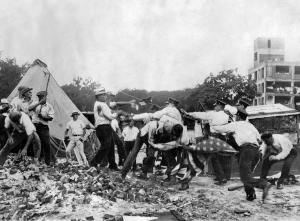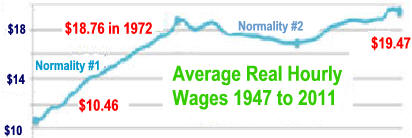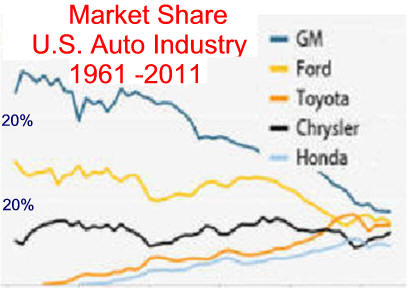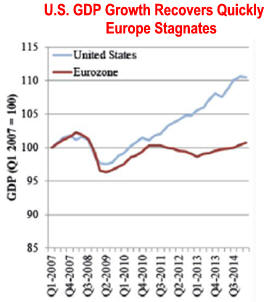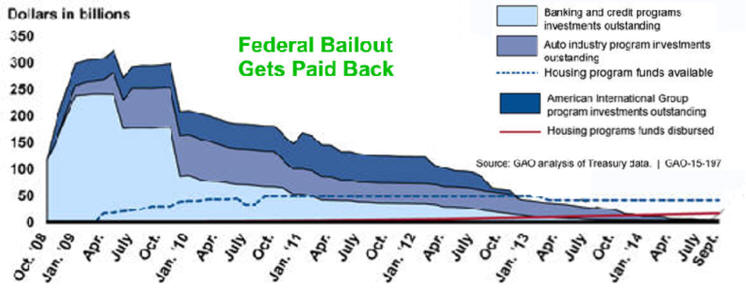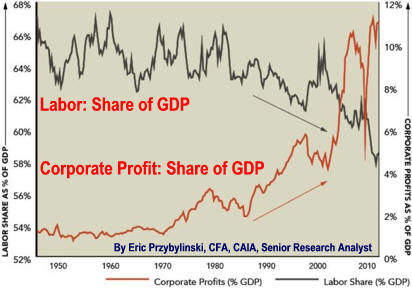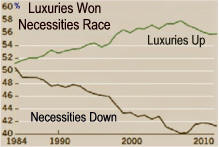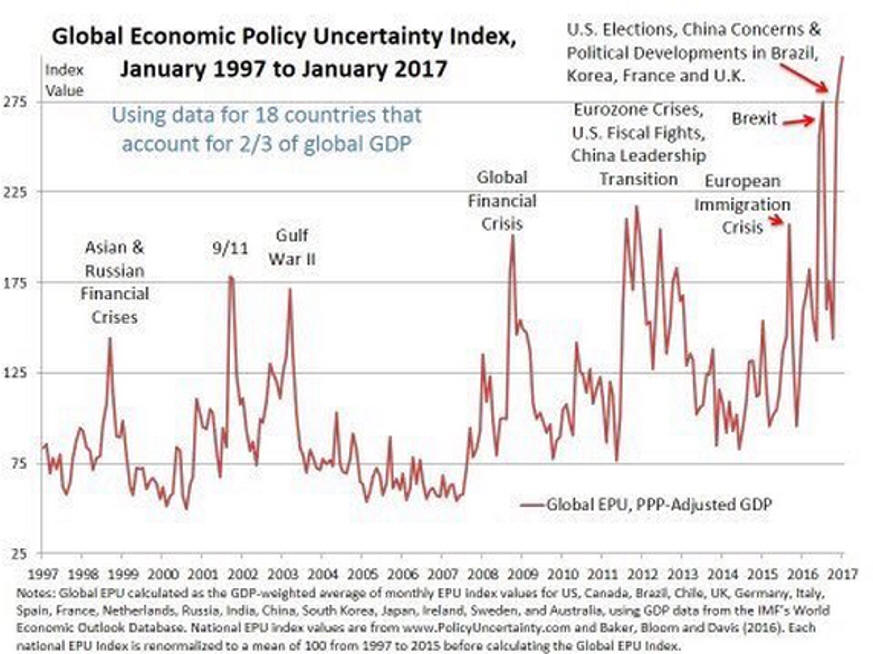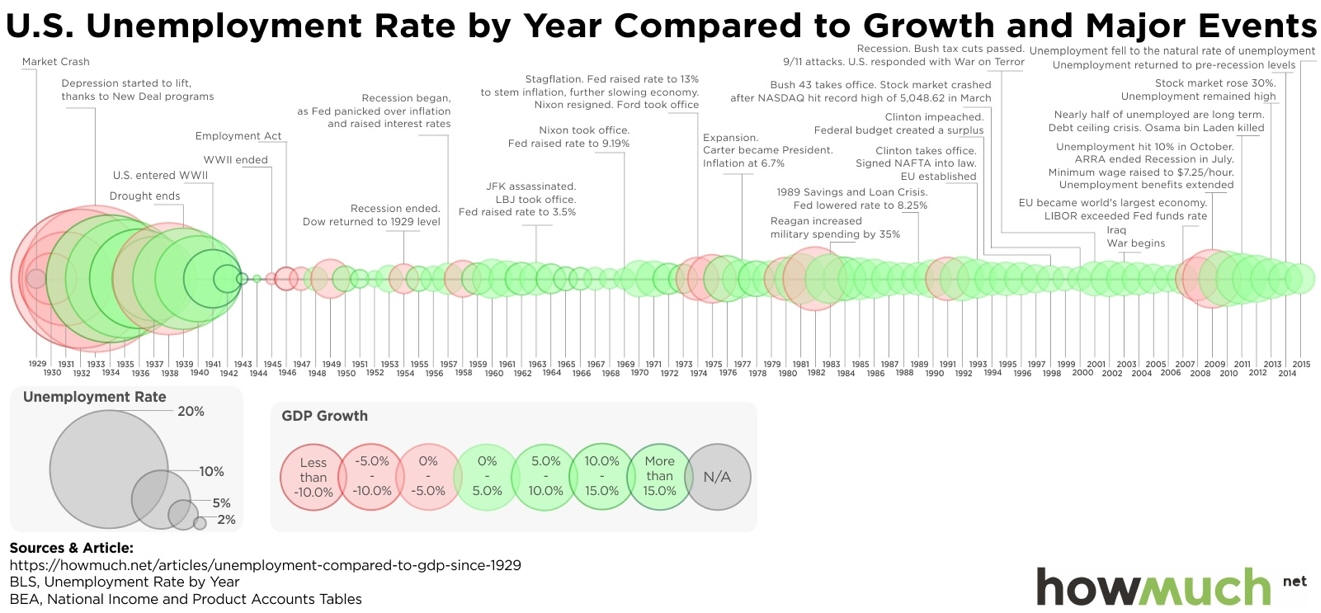|
U.S. Economic History Since 1900 Part 1 A New Decade Brings Change Populists End to the Gilded Age Depression Brings Government Safety NetPart 2 US Dominance Economic Normal Changed World Changed and Good Jobs Disappeared Great Recession 1p or 3 pPart 3 The 20th Century Most Severe Recessions Recent Decades Ranked by Problems 20th Century Decade Evaluation History of US Banking Part 4 Difficult Beginning for 21st Century The Cost of 20th Century Wars U.S. Terror Episodes Since 1900 updated 9/14817 Please |
|
|
Part 1 A New Century Brings Change |
|
|
Populists
End to the
Gilded Age
but
Business Power Would Return
After WW I..
The 1896
realigning election resulted in a republican forged conservative coalition
consisting of businessmen, professionals, skilled factory workers, and
prosperous farmers. There would be
opposition which created two unsettled decades called the |
1)
The 1898
Spanish–American War
victory resulted from our desires for a colonial empire and business interests.
Business also had pushed for the 1897
Dingley Tariff Act which promoted industry
at the expense of consumers as the tariff was added to the price paid by consumers. The
Gold Standard protected savers
but its inflexible money supply caused hard
times. 2) The Panama Canal acquisition of 1903 eventually resulted in improved transportation. 3) Progressive Republican FDR successfully fought party Trusts. First with the 1906 Meat Inspection Act and Pure Food & Drug Act. The Hepburn Act increased Interstate Commerce Commission regulation of Rail Road Trusts which still managed to control rates and competitors. 4) American Antiquities Act of 1906 created National Monuments and was one of many conservation activities. 5) Panic of 1907 needed help from both J.P. Morgan and the Treasury as more liquidity was needed than his wealth could provide. The 1913 the Federal Reserve System resulted and it became the Lender of Last Resort. Designed by Wall Street bankers the FED would continue under Wall Street's thumb until ... 2015 and counting! Think Great Recession. 6) Democrat Woodrow Wilson would continue progressive the agenda. The Revenue Act of 1913 substituted income taxes for lower tariffs and this lowered the price of consumer goods. The Federal Trade Commission Act of 1914 was a major effort to control business trusts. The Clayton Antitrust Act of 1914 outlawed specific conduct putting teeth into Sherman Antitrust Act. The Federal Farm Loan Act of 1916 increased credit to rural family farmers and the Keating–Owen Act of 1916 temporally lowered child labor abuses.. 7) Segregated government continued as Wilson was like progressives T Roosevelt and T Jefferson in that he felt Americans were not ready for integration. 8) Revenue Act of 1921 and Revenue Acts of 1924,1926,1928 reduced taxes so only richest 2% paid income taxes. Think 2 Bush tax cuts. The Fordney McCumber Tariff Act was one of many protectionist measures during the decade. Smoot–Hawley Tariff Act of 1930 to protect US industries failed to help as Canada, France and others retaliated. A Mexican Repatriation program help unemployed Mexican citizens return home. It represented forced migration. Think current immigration problems. 9) Great Mississippi Flood of 1927 resulted in the Flood Control Act of 1928. It created the U.S. Army Corps of Engineers to watch over public infrastructure.. 10) The 16th, 17th, and 19th amendments made some progressive policies permanent. |
|
Depression Brings Hoover had trouble helping during the Great Depression. Tension increased when the U.S. Senate refused to agree with the House which had and move up the payment of a WWI veteran bonus. There was much distress from high unemployment. A 1932 Army of U.S, Veterans march on Washington for their bonuses. Trouble resulted. Over the years many have marched, some have died. FDR would bring change. Liberals around the world said socialism was the economic answer to depression. The Share the Wealth movement was founded by Louisiana Governor Huey Long was one of many liberal social activists seeking political power throughout the U.S. and Western Europe. He would later be assassinated.These activities would be countered by conservative banker and business leader oligarchs who backed Herbert Hoover’s use of laissez fair Classical economic policy. Hoover's first policy mistake was to follow the Republican party against his own beliefs of those of many economists. Signed the Smoot-Hawley Tariff Act caused many countries soon followed and the resulting decrease in world trade hurt everyone. The Federal Reserve tried to maintain the Gold Standard with two discount rates increase of 1 point each. Then there was the Revenue Act of 1932 which dramatically increased federal taxes. Both were right out of the Classical Economics toolbox. So was the $200,000,000 U.S. bank loans to keep Britan on the Gold Standard. All efforts failed. Britan went off the Gold Standard first followed the U.S. in 1933. The economy hit bottom in 1933 and spending printed money was the only way out of deflation which made existing loans more expensive in real terms and also made business less apt to borrow. Hover lost the 1932 election. as FDR promised to use liberal Keynesian economic government action to solve the continuing economic recession. |
Members of the Bonus Army camped out on the lawn of the Capitol building in mid 1932. Click for larger photo.
Shacks that members of the
Willis C. Hawley (left) and
A 1936
impoverished
American family living in |
His New Deal employment programs would be the first time U.S. government would use massive debt to solve a major non-military problem. Like the war debt from WWI and following wars, the debt would not be paid back. As debt was retired the funds came from new debt. Inflation and economic growth would ease the pain of interest payments. Major legislation included the Social Security Act which covered Old-Age, Survivors, & Disability Insurance, the Fair Labor Standards Act/1938 which set maximum work hours and minimum wages, the Agricultural Adjustment Act/1938 which provided fair price for farmers, and the Prohibition Discriminatory Employment related to federal employment .The Wagner Act along with other pro labor reforms were also passed. Conservative fought back using a conservative Supreme Court which declared some New Deal legislation illegal. The battle over Keynesian vs. Classical Economics continues today. Many conservatives do not mind government action and debt for military problems but disagree with Liberals who want to use debt to solve economic problems. Both oligarchies to date have not believed that cost effectiveness applies to their perceived governmental responsibilities. Politicians from both political parties act unhappy despite benefiting from an electorate that lives much better because of massive federal annual deficits. Also helping voters is the economic benefits of an annual balance of payments deficit amounting to $1,700 per person. The later represents cheap goods from abroad. Dollars accumulate and eventually return to the U.S. in the form of public and private US financial instruments, US travel and fixed assets. Voters let politicians buy their vote with these debts disliking all members of Congress but their own! After Germany invaded Poland starting World War II President Roosevelt asks the Congress for a defense budget hike and the United States declares its neutrality. Many wanted the U.S. to stay out of the war and just as many profited as U.S. loans to Europe,, Loans were spent with US companies that supplied war arms and food to belligerents. |
|
#1 Rising Income
WW 2 generated savings, pent-up demand and few foreign few competitors generated 25 years of high profits higher wages and cooperative unions. Normality ended when Carter appointee FED Chairman Volker found higher interest rates were not enough so he lowered commercial bank reserves. This quickly pushed the Federal Funds Rate to 20%. Banks
|
would not loan. Two recessions followed. The first cost Carter reelection and the second, though severe, was over so Reagan was reelected. |
|
#2 Increased Foreign Competition Began 1970's Wage Stagnation |
|
|
High Oil prices pushed Japan into more valued added exports like
automobiles, machinery and computers. This competition caused a
stagnate Rust Belt with lower wages and eventually lower employment.
Japan's manufacturers got lucky from increased demand for gas
efficient small green cars with catalytic converters. Detroit
protected profit by seeking tariff protection. Investment
needed to lower cost and increase product quality was ignored.
Auto union leaders protected their positions. Current worker
protected existing jobs and salaries by accepting a
two-tier wage system. It minimized the need for new
workers who would receive lower wages for a similar jobs. Feeling
political pressure Japan built many modern U.S. plants often in the
nonunion southern states offering the highest tax incentives.
Use
PDF for Color Printing.
provided by textbooksfree.org |
|
|
#3
1980's Failing Manufacturing and Less Financial Regulation Events Causing Financial Instability Causes Great Recession 1980's U.S. and England Returned to Conservative Lax Business Regulation because increased regulation and increased welfare provisions had upset many voters. Think Great Society and lax derivative regulation which result in major increases hostile leveraged buyouts plus and over-investing in Real estate caused. They caused the Savings and Loan Crisis. Think Michael Milken Scandal, Keating Five results from poor Alan Greenspan advise. 1980's Major Investments Banks Went Public creating a need to balance client needs with equity needs. Think expansion of financial industry's share of GDP. 1980's Accounting Standards Declined as accountancy firms struggled to balance commitments to audit standards with the desire to grow their consultancy business. Think off-balance-sheet items and Arthur Anderson Scandal. 1980's Home Equity Loans Increased Current Consumption and Lowered Savings as they replaced equity building home improvement loans. Think many not prepared for retirement. 1983 Reverse Mortgages Approved for FHA loans. Think less retirement savings. 1986 Big Bang deregulates London's financial services industry, other will follow. 1999 Gramm–Leach–Bliley Act Increased Systemic Financial Risk once limited by the Glass-Steagall Great Depression Act. Initiated by Republicans it was signed by President Clinton. Think financial industry expansion. See Five Bad Bush/Clinton Policies 2004 Uptick Short Rule of 1938 rescinded. Think stock market gambling. 2006 FASB requirement that housing assets be mark-to-market decreased financial system collateral. Action resulted from a 1991 Government Accountability Office investigation of the $160,000,000,000 savings and loan bailout. Think moral hazard.
From Financial Crisis to
Recession to Great Recession to Recovery |
|||||
|
Understanding Balance Sheet Recessions
They are infrequent, severe, and long-lasting. Understanding them is necessary when judging society's efforts to manage The Great Recession. It is like understanding a doctor's attempt to relieve a headache requires knowing the level of difficulty. Was it a Migraine Headache? A balance sheet is caused by high levels of private sector debt. Assets must equal liabilities plus equity. If assets values like housing collateral fall below their associated debt, equity must make up the difference or insolvency results and debt must be repaid. Think 1837, 1873, 1890 & 1929 See Most Severe US Recessions. Was Our Great Recession a Balance Sheet Recession? Economist Paul Krugman feels the financial crisis ..."was one manifestation of a broader problem... associated with a "balance sheet recession." Economist Richard Koo wrote Japan's 1990- ? "Great Recession "was a "balance sheet recession."
Great Recession Stages
1. A more complex unstable financial/credits system resulted in extreme optimism in
good times and panic in bad times. Think Think savings from China and Russia and other re. 3. Aggregate demand stagnated as trade surplus countries didn't spend. Germany's 2005 economic renewal was saved and Japan's private sector saved much more after their 1990's credit bubble exploded. Adding to the demand shortage were companies who maintained profit by decreasing capital investment spending despite historically low interest rates. Globalization and technology also helped them maintain profit as wage increases were limited to most valuable employees. State and local governments, especially those with underfunded pension systems, also cut expenditures. Think Mercantilism. 4. Increased current account deficits by wealthy nations balanced world trade. Higher demand for foreign goods was made possible by massive central bank supported low interest loans. The FED's historic monetary expansion was made possible by continued low inflation caused by expanded Flat World competition and low oil prices. Innovative financing and lax financial regulation also fostered expanded financial asset demand. Think excess OPEC savings financed the 1970's Latin American Debt Crisis leading to Savings and Loan Crisis. 5. Real Estate and Stock bubbles came as expected from low long-term real interest rates. New home buyers borrowed surplus savings and investors devoured growing unique debt securities created by an expanding finance industry promising insured difficult to understand almost guaranteed financial instruments. Leverage rose dramatically. Fraud, near fraud and data manipulation exploded as mortgage servicers, banks, and the law firms broke the law to force people out of their homes. See Chain of Title and Brief History of Financial Bubbles. 6. Poor Crisis Management by politicians as their economic advisors believed market capitalism would prevent serious recessions. The Great Moderation solidified this view. Possibility of new financial instrument contagion were not understood. When panic started, political, intellectual and bureaucratic leaders resisted quick action in areas that required cooperation. A US depression was avoided by FED, Treasury and Congressional efforts that were slowed by austerity. Iceland, Ireland, Greece, Spain and Portugal experienced economic depression. See The Great Recession. See Bubbles Credit and Their Consequences to see FED analysis of trying to slow down a bubble. |
|||||

